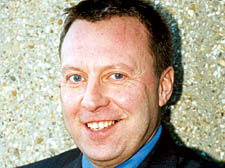|
|
 |
| |

Neil Litherland |
Toddler’s death under toppled wall was ‘an accident waiting to happen’
Town Hall declines to challenge jury’s verdict ‘to avoid further distress to the family’
THE parents of a two-year-old boy who died when a wall collapsed on top of him have called on Camden Council to make safe all its properties to prevent a similar tragedy
Saurav Ghai was crushed when a boundary wall on the Wendling estate in Southampton Road, Gospel Oak, gave way as he walked past with his childminder during gale-force winds in January.
His parents, Vinay and Desiree, said on Friday that it was “an accident waiting to happen” after hearing three days of evidence at a coroner’s inquest. The nine-strong jury ruled that there were defects in the wall.
In a statement, the Belsize Park couple said: “We hope that in future Camden ensures satisfactory controls are put in place to ensure the structural integrity of their properties.
“We also hope that the council will have the courtesy to inform us what actions it takes. We did note the opinion expressed by the coroner that this was, and we quote, ‘an accident waiting to happen’.
“We will put our minds now to preserving the wonderful memories our son gave us, our family and friends.”
Their comments – the first time they have spoken publicly about the tragedy – came as housing chiefs took the unprecedented step of claiming that the jury in the case had not obeyed instructions from St Pancras coroner Dr Andrew Reid. The verdict could easily be challenged in law, they maintained.
Assistant chief executive Neil Litherland said the only reason the council would not turn its top legal guns on the case was that it risked causing more heartache to Saurav’s family. He said: “Although the jury’s verdict considered matters of fact about the nature of the structure of the wall which were not addressed in evidence and went beyond the basis of the direction given to them by the coroner, we feel that, although this could be corrected by legal process, we will not be seeking such an order to avoid further distress to the family.”
Dr Reid had told the jury that they could not attribute blame and could only return a verdict of accidental death with a narrative of the incident.
When the nine-strong panel returned – after three hours of deliberation – the foreman said the wall had not been made with “usual bricklaying methods” and the use of metal ties between the bricks was not “preferable” (see below).
The inquest heard how Saurav could not be revived after being taken to hospital. His childminder was injured but was later discharged from hospital.
The section of wall had been repaired 10 years ago by a firm called Chatterton, according to council records. Directors of the company have not been traced.
Two surveyors examined the wall in the six months before the storm but no immediate risk was flagged up.
Savills, the company hired to inspect the wall, said it had not been asked to make a full structural test and had instead made a visual inspection for a stock condition survey.
Mr Litherland said: “We offer the Ghai family our deepest sympathy following the inquest into the death of their son, Saurav.
“We carried out our own fact-finding investigation to establish whether the council-owned wall had posed a threat to the public. We discovered that the wall had undergone three independent surveys in the past five years, two of which were in the months immediately before it fell during the storm.
“The surveys did not identify an urgent need for repairs on this wall. The council has also invested £80 million this year to ensure health and safety of our housing remains a top priority to protect the safety of residents and visitors in the borough. This includes repairing any other damage caused by the storm.” |
 |
|
|
 |
|
 |
|